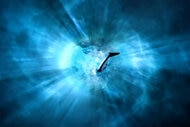Create a free profile to get unlimited access to exclusive videos, sweepstakes, and more!
Some of the Universe's Oldest Stars Have Been Found Circling Our Own Galaxy
These seemingly immortal stars are stowaways from ancient, dead galaxies.
The fictional Connor MacLeod (Christopher Lambert) was a member of an ancient group of seemingly immortal beings. While most of us live hardly a century if we’re lucky, they’ve walked the Earth for hundreds or thousands of years, hoping to be the last one standing. It’s a fanciful story for humans, but Highlander-like stars are very real.
Recently, a group of astronomers from MIT, including a handful of students, discovered three of the oldest stars in the universe, alive and well inside of our own galaxy. The discovery was published in the Monthly Notices of the Royal Astronomical Society.
Some of the Oldest Stars in the Universe are Hitching a Ride in the Milky Way
The stars were found in the Milky Way's halo, a cloud of stars that encircles the main galactic disk, but they formed elsewhere, as part of the very first galaxies at the dawn of the universe. Students used data collected by MIT professor of physics Anna Frebel, using the 6.5-meter Magellan-Clay telescope at Las Campanas Observatory.
They started by sifting through the data, hunting for stars with low levels of elements heavier than hydrogen and helium (low metallicity). Heavier elements are formed in the hearts of massive stars and through other energetic processes like supernovae. They tend to show up in greater amounts in second-generation stars or later, which have been enriched by the cosmic corpses of their stellar forebears. They found three stars that fit the bill, suggesting ages between 12 and 13 billion years.
For More on Stars:
Black Holes "Burp" After Gobbling Up Stars
After a Fiery Embrace, Some Stars Undergo Metamorphosis
MACHO Star System Has Supersonic Tidal Waves Taller Than the Sun
When the team analyzed spectral data from these stars, they found compositions consistent with faint dwarf galaxies from the early universe. Another piece of evidence came from the way these stars move. While most stars in the Milky Way are all moving in the same direction around the galactic center, these three are cruising the wrong way. If the galaxy is a one-way roundabout, these stars are driving into oncoming traffic. That suggests they came from somewhere else and made a wrong turn getting off the onramp.
“The only way you can have stars going the wrong way from the rest of the gang is if you threw them in the wrong way,” Frebel said, in a statement. Dubbed SASS stars, short for Small Accreted Stellar System stars, they are believed to be the only surviving remnants of primitive galaxies which were gobbled up by the still-growing Milky Way, billions of years ago.
In addition to being long-lived ancient stars, the last of their respective galaxies (there can be only one, after all), they also provide a potential window into the early universe. Because light takes time to reach us, we can peer into the past by looking farther away. Light coming from a billion light-years away is necessarily a billion years old by the time it reaches us. It’s a fortunate consequence of physics, but it comes with downsides.
As the universe expands, light from distant locales gets stretched out, becoming fainter, harder to see, and slipping into invisible parts of the electromagnetic spectrum. To date, studying stars from the earliest galaxies has meant soaking up light from billions of light-years away using incredibly advanced telescopes like Hubble and JWST. Now, we have a new way of studying those stars much closer to home. What’s more, Frebel and team suggest there should be more of these ancient stars still surviving in the Milky Way.
“These oldest stars should definitely be there, given what we know of galaxy formation,” Frebel said. “They are part of our cosmic family tree. And we now have a new way to find them."
Then again, maybe the immortals (stars or otherwise) are better left to their own devices.
Catch Highlander: The Animated Series, streaming now on Peacock.



















